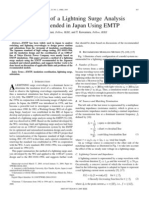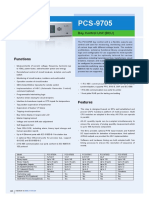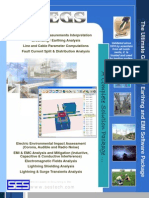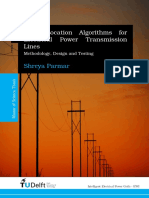Substation Grounding Grid Design Using Alternative Transients Program-ATP and ASPIX
Uploaded by
Jose Dariel ArcilaSubstation Grounding Grid Design Using Alternative Transients Program-ATP and ASPIX
Uploaded by
Jose Dariel ArcilaGROUNDING GRID DESIGN
PAGE 1
Substation grounding grid design using Alternative Transients Program-ATP and ASPIX
This example shows the method for designing a grounding grid following the standard IEEE 80 safety criteria. It shows the procedure for designing the grounding grid of a substation with voltage levels of 115 kV and 34.5 kV.
1 Software
This example of the design was developed with the aid of the following software: Alternative Transients Program (ATP): Licensing to use ATP is free of all charges for all who are not engaged in EMTP commerce. For information on the licensing and user groups, visit the website: http://www.emtp.org/ Aspix: You may obtain a trial version for 30 days. This version allows you to run simulations and observe the results; however, you cannot save or generate reports. You can request a 30-day free license without functionality limitations. The program can be downloaded from the following website: http://www.spartalightning.com/products/aspix Aspix Resistivity Analyzer: It is an Excel spreadsheet that allows the processing of the resistivity measurements to obtain a two-layer model. This spreadsheet sheet is available for free and can be downloaded from the website: http://www.spartalightning.com/download
2 Design method
The method for designing the grounding grids includes the following steps: 1. 2. 3. 4. 5. 6. 7. Measuring and analyzing the soil resistivity. Plotting the grounding grid layout. Calculating the grounding grid resistance with the initial design. Calculating the earth current distribution. Calculating the touch and step voltages. Verifying the touch and step voltages. Redesign of the grounding grid when the calculated touch and step voltages are higher than the tolerated values; the procedure is repeated from point 2.
3 Input information
The following information is required for designing the grounding grid: Single line diagram of the power system Short-circuit levels Parameters of the power transformers Substation plan view Measurements of the soil resistivity
http://www.spartalightning.com/
GROUNDING GRID DESIGN
PAGE 2
4 Description of the case
This is an example of the design of the grounding grid of a substation with voltage levels of 115 kV and 34.5 kV, with three lines of 115 kV, a 25-MVA power transformer, and three 34.5-kV distribution circuits. The single line diagram is shown in Figure 1, and the substation for which the grounding grid is designed is the load 1 substation.
Source Substation 230 kV 150 MVA Ynyn0D11 Z1 = 14% Z0= 14% Short Circuit Equivalent Isc1 = 7 kA Isc3 = 9 kA
115 kV
Double circuit line 36 km 115 kV
Single circuit line 58 km 115 kV 25 MVA Dyn5 Z1 = 12% Z0= 12% Load 2 substation 25 MVA Dyn5 Z1 = 12% Z0= 12%
Load 1 substation
34,5 kV
34,5 kV
Figure 1. Single line diagram
The substation is composed of three line bays of 115 kV, one 25 MVA transformer, one 115 kV transformer bay, and four 34.5 kV bays (three for the distribution circuits and one for the power transformer), as shown in Figure 2.
http://www.spartalightning.com/
GROUNDING GRID DESIGN
PAGE 3
Figure 2. Substation plan view
The substation has a layer of crushed rock of 20 cm thickness and with a resistivity of 2500 m. The maximum time of fault clearance is 500 ms. The cables of the mesh have a depth of burial of 50 cm.
5 Resistivity measurements
The measurements are obtained using the Wenner method for a separation of the electrodes of up to 8 m and using the Schlumberger-Palmer method for a separation of the voltage electrodes of up to 32 m. The soil resistivity measurement data are summarized in Table 1.
http://www.spartalightning.com/
GROUNDING GRID DESIGN
PAGE 4
Table 1. Resistivity measurements Wenner Method
a (m) a (m)
Schlumberger-Palmer Method
c(m) a (m) c(m)
2 193.1 167.7 222.3 245.2
4 168.5 185.3 129.5 175.6
8 139.6 185 117.9 84
16 101.7 211.4 164.4 147.2
32 210.7 66.9 123.4 93.2
The Aspix Resistivity Analyzer is used for processing the resistivity measurements and to obtain the two-layer model. This processor is an Excel spreadsheet that generates a curve of resistivity with a probability of non-exceedance of 70%. From this curve, Aspix Resistivity Analyzer tries to find the values of the upper-layer resistivity, bottom-layer resistivity, and depth of the top layer that best suit to the obtained measurements. This tool displays a graph where the user can observe the resistivity measurements and the values calculated by the analyzer, allowing comparison of the model with the measurements. Table 2 summarizes the processing of the resistivity measurements in Table 1.
Table 2. Earth resistivity measurement processing
Resistivity Analyzer
Equally Spaced - Wenner Method Profile 2 P1 (Ohm_m) P2 (Ohm_m) P3 (Ohm_m) P4 (Ohm_m) P5 (Ohm_m) P6 (Ohm_m) P7 (Ohm_m) P8 (Ohm_m) P9 (Ohm_m) P10 (Ohm_m) Average Std Dev Resistivity_70% 207.1 164.7 131.6 33.82 24.47 42.3 223.6 177.4 150.4 156.175 45.334 177.134 165.02 123.55 62.518 145.573 162.309 0 0 5 4
a (m)
Unequally Spaced - Schlumberger-Palmer Method
a (m) c(m) a (m) c(m) a (m) c(m) a (m) c(m)
Resistivity Analyzer Version 1.0 http://www.spartalightning.com/
Resistivity_70% Resistivity 2LModel
8 185 84
16
32
250
193.1 168.5 139.6 167.7 185.3 245.2 175.6 222.3 129.5 117.9
101.7 211.4 164.4 147.2
210.7 66.9 123.4 93.2
Resistivity (ohm-m)
200
150
100
50
Resistivity 2LModel 223.3 176.7 146.8
10 15 20 25 30 Voltage Electrodes Separation Distance a (m)
35
Estimated 2 layer soil parameters Upper Limit Lower Limit 1 (Ohm_m) 256.14 10000.00 1.00 2 (Ohm_m) 136.35 10000.00 1.00 k H(m)
I V Analyze a a a Wenner Method
I V
c c a Schulumberger-Palmer Method
-0.31 1.82
0.99 20.00
-0.99 0.10
The resistivity analyzer provides the following parameters for the two-layer model: Resistivity of the upper layer (1) = 256.14 m Resistivity of the bottom layer (2) = 136.35 m Depth of the top layer (H) = 1.82 m
http://www.spartalightning.com/
GROUNDING GRID DESIGN
PAGE 5
6 Initial design
6.1 Grounding grid layout
The design of the grounding grid must be such that it ensures the safety of persons against failures, and requires the minimum amount of materials and work. In the design method, initially a mesh is drawn on the substation layout covering all the substation equipment. This first layout of the grounding grid must take into account the following: All the substation equipment require at least one ground pigtail for their structures. When the substation has a metallic fence, a ground conductor can be buried outside the fence in order to control the touch voltages. Normally, it is a cable installed 1 m outside the fence, buried at 50-cm depth. This cable must be interconnected with the internal grounding grid every 20-50 m, depending on the soil resistivity. A cable around the transformers, outside the transformer foundation. A cable outside the gantry foundations. The minimum number of cables required to facilitate grounding of all the equipment and their structures are drawn. In the case of the above example, the fence is a brick wall; therefore, it is not necessary to install a buried cable outside the fence. Figure 3 shows the plan view of the substation and the grounding grid drawn according to the above mentioned criteria.
http://www.spartalightning.com/
GROUNDING GRID DESIGN
PAGE 6
Figure 3. Grounding grid layout
Below is the analysis of the grounding grid to know whether this first design meets the safety requirements or whether it is necessary to improve it.
6.2 Grounding resistance
Once the soil resistivity data and the geometry of the grounding grid are known, the grounding resistance value can be calculated. Initially, the value of the maximum current that circulates through the grounding grid is not known. This current is calculated later, and it is not required to know its value for the calculation of the resistance of the grounding grid. As the program requires this current value, we can select a value of 1000 A. Table 3 lists the parameters that are used for the simulation.
http://www.spartalightning.com/
GROUNDING GRID DESIGN
PAGE 7
Table 3. Simulation parameters
Aspix parameter
Upper layer resistivity (m) Lower layer resistivity (m) Upper layer thickness (m) Crushed rock resistivity (m) Thickness crushed rock surfacing (m) Fault duration (s) Maximum grid current (A)
Value
256.14 136.35 1.82 2500 0.2 0.5 1000
These parameters are entered in the Aspix program using the Simulation option in the Simulation Settings menu. Figure 4 shows the parameters entered in the program.
Figure 4. Aspix simulation settings
The next step is to enter the physical data of the grounding grid in the program. For this, the wires and rods that make up the mesh of the grounding are added. In this example, the mesh of the grounding is composed only of horizontal conductors, which are added by right-clicking on Horizontal Conductors and then clicking on New Conductor. Figure 5 shows the data that must be entered by each conductor.
http://www.spartalightning.com/
GROUNDING GRID DESIGN
PAGE 8
Figure 5. Horizontal conductor data
Once the conductor details are entered, the user can observe the plan view of the grounding grid. The plan view is displayed with the Grid Plan View option in the View menu, and it appears as shown in Figure 6.
Figure 6. Grounding gridinitial design
The simulation is run using the Run option in the Simulation menu. The results are displayed using the Results option in the Simulations Results menu. The program displays a window with the results table as shown in Figure 7.
http://www.spartalightning.com/
GROUNDING GRID DESIGN
PAGE 9
Figure 7. Simulation results
Thus far, only the grounding grid resistance value (2.267 ) has been calculated. The touch and step voltages have not yet been calculated given that the value of the current passing through the grounding grid is required.
6.3 Earth fault current distribution
The calculation of the touch and step voltages requires the knowledge of the maximum grid current value. A first approximation is to assume the value of this current as the maximum value of the ground fault current in the substation, by taking into account all the voltage levels. This approach can work in some cases; however, it can be very conservative and expensive. For a less conservative design, the value of the maximum grid current can be more accurately calculated. The ground fault current flows through both the grounding grid and the ground wires of the transmission lines and distribution circuits. There are different methodologies to determine the earth fault current distribution; in this example, the detailed simulations of the ground faults are performed using the ATP program. In the case under analysis, it is important to take into account the fault current to the ground that is derived through the ground wires of the 115-kV lines. Therefore, the tower footing resistances closest to the substation should be modeled in detail. Table 4 summarizes the data of the phase conductors and ground wires and the tower configuration.
http://www.spartalightning.com/
GROUNDING GRID DESIGN
PAGE 10
Table 4. 115 kV-lines parameters
By assumed an average span of 300 m and a tower footing resistance of 30 , the 20 sections of the line closest to the substation (6 km) are modeled in detail, and the remaining part is modeled as a single section. Figure 8 shows the network modeled using the ATP program.
Source substation Load 1 substation
Load 2 substation
Tower footing resistance
Grounding grid resistance
Figure 8. ATP simulated network
A single phase and two phases to the ground faults are simulated, at the levels of 115 kV and 34.5 kV. The case in which more current passes through the grounding grid corresponds to a two-phase ground fault on a 34.5-kV circuit at a point very close to the substation, by assuming that the 34.5-kV circuits do not have a ground wire. Figure 9 shows the distribution of the ground fault current.
http://www.spartalightning.com/
GROUNDING GRID DESIGN
PAGE 11
115 kV
Ground wire
34.5 kV
2720 A 875 A Towers footing resistances Grounding in the fault point Substation grounding grid 1121 A 815 A Ground wire 2720 A
Towers footing resistances
Figure 9. Most critical earth current distribution
The currents cannot be added arithmetically because there is an angle of deviation between them mainly caused by the inductive component of the ground wires; this lag can be observed in Figure 10.
4000 [A] 3000 2000 1000 0 -1000 -2000 -3000 -4000 0.00
Fault ground current and transformer neutral current Substation grounding grid current Lines ground wires current
0.02
0.04
c: -MALL
0.06
c:CG1 -MALL
0.08
c:CG2 -MALL
[s]
0.10
(f ile Ejemplo_Aspix.pl4; x-v ar t) c:MALL -NEUT c:FALL -
Figure 10. Earth currents
The maximum current value through the grounding grid is 1121 A, and it is the value that is used to calculate the touch and step voltages.
http://www.spartalightning.com/
GROUNDING GRID DESIGN
PAGE 12
The effect of the direct current component of the short-circuit current is negligible given that the X/R relationship of the system in the substation analyzed is less than 10 and the fault duration is 500 ms.
6.4 Touch and step voltages
For calculating the touch and step voltages, the value of the current through the grounding grid must be set to 1121 A. This value is changed by the Simulation Settings option in the Settings menu, and the parameter Maximum Grid Current (A) should be changed (see Figure 4). The regions or areas in which the touch and step voltages are calculated must be added. These regions are selected by taking into account the following criteria: The step voltages must be controlled both inside and outside the substation; however, it is not necessary to calculate them in very large areas because the highest step voltages appear on the perimeter of the grounding grid. Therefore, when we control the step voltages on the perimeter, we control them elsewhere. Therefore, a good approach is to calculate the step voltages in a region that covers the total area of the grounding grid. The touch voltages must be controlled at all the sites where people can touch the grounded structures (steel structures, transformers, electric panels, metal poles, etc.). Usually, these grounded structures are located within the area covered by the grounding grid. Therefore, a valid criterion is calculating the touch voltages in a region that covers the entire area of the grounding grid. The areas in which the touch and step voltages are calculated are added by right-clicking on Chart Areas and then clicking on the New Chart Area. The program displays a window that is shown in Figure 11.
Figure 11. Touch and step voltages chart area data
The areas that can be defined using the Aspix program are rectangular in shape and are defined by the coordinates of the starting point (x, y), number of points in the X and Y directions, and distance between the points or resolution. For the case that is being analyzed, the five areas that are shown in Figure 12 can be defined.
http://www.spartalightning.com/
GROUNDING GRID DESIGN
PAGE 13
Area 5
Area 4
Area 3 Area 2
Area 1
Figure 12. Areas for simulation
Once the chart areas for simulation are defined, the simulation is run with the Run option from the Simulation menu. Further, the results are observed using the Simulations Results option of the Results menu, and the results table is shown in Figure 13. The results table displays a summary of the simulation; we can observe the values of the grounding resistance and the calculated maximum touch and step voltages values in the defined chart areas. In addition, we can observe the tolerable touch and step voltages for people of 50 kg and 70 kg of weight in accordance with the standard IEEE 80. In this example, the safety criterion is not to exceed the tolerable touch and step voltages for persons of 50 kg of weight. Aspix also generates the touch and step voltages charts for all the configured areas. These charts can be twodimensional or three-dimensional and can be displayed using the options Touch Voltage 3D Chart, Step Voltage 3D Chart, Touch Voltage Chart 2D, and Step Voltage Chart 2D in the Results menu. These charts are shown in Figure 14, Figure 15, Figure 16, and Figure 17, respectively.
http://www.spartalightning.com/
GROUNDING GRID DESIGN
PAGE 14
Figure 13. Simulation results
Figure 14. Touch voltage3D view
http://www.spartalightning.com/
GROUNDING GRID DESIGN
PAGE 15
Figure 15. Touch voltage2D view
http://www.spartalightning.com/
GROUNDING GRID DESIGN
PAGE 16
Figure 16. Step voltage3D view
Figure 17. Step voltage2D view
As can be observed in the results table shown in Figure 13, the tolerable touch voltage for a 50-kg person is 677.8 V, and this value is exceeded by the calculated touch voltage of 914.2 V. The step tolerable voltage is
http://www.spartalightning.com/
GROUNDING GRID DESIGN
PAGE 17
2219.1 V and is above the calculated step voltage of 406.5 V. In summary, with this initial design, the tolerable touch voltage is exceeded, i.e., the design does not meet the safety criteria and should therefore be modified.
7 Modified design
7.1 Grounding grid layout
The modifications to the initial design must be oriented to the reduction in the touch voltages, for which there are different alternatives such as follows: The ground potential rise (GPR) is decreased, for which the alternatives are as follows: reduce the grounding grid resistance or decrease maximum current through the grounding grid. The space between the parallel conductors is reduced by adding conductors on the inside of the grid of the initial design. The first option is to attempt to decrease the touch voltage by reducing the space between the parallel conductors. This requires identifying the points where the tolerable touch voltage is exceeded. The regions where the tolerable touch voltage is exceeded appear circled as shown in Figure 18, and the modification of the design consists of adding cables in these regions. Figure 19 shows the modified design.
http://www.spartalightning.com/
GROUNDING GRID DESIGN
PAGE 18
Figure 18. Most critical touch voltages
Figure 19. Grounding gridmodified design
7.2 Grounding resistance
The program is run and a grounding grid resistance of 2.09 is obtained, as shown in Figure 20.
http://www.spartalightning.com/
GROUNDING GRID DESIGN
PAGE 19
Figure 20. Resultsmodified design
7.3 Distribution of currents to the earth
The value of the grounding grid resistance of the substation 1 (see Figure 8) is modified in the ATP program, and the simulation is run. Figure 21 shows the distribution of the ground fault current.
http://www.spartalightning.com/
GROUNDING GRID DESIGN
PAGE 20
115 kV
Ground wire
34.5 kV
2732 A 856 A Grounding in the fault point
Towers footing resistances
Substation grounding grid 1188 A 793 A Ground wire
2732 A
Towers footing resistances
Figure 21. Distribution of ground fault currentmodified design
The maximum current value through the grounding grid is 1188 A, and it is the value that is used to calculate the touch and step voltages.
7.4 Touch and step voltages
For calculating the touch and step voltages, the current value of 1121 A passing through the grounding grid must be changed to 1188 A, which is obtained for the modified design. This value is changed by the Simulation Settings option in the Settings menu, and the parameter Maximum Grid Current (A) should be changed (see Figure 4). The areas for the calculation of the touch and step voltages are the same as those used for the simulation with the initial design. The program is run with the Run option from the Simulation menu, and with the option Simulation Results in the Results menu, we can observe the results table as shown in Figure 22.
http://www.spartalightning.com/
GROUNDING GRID DESIGN
PAGE 21
Figure 22. Resultsmodified design
Figure 23 and Figure 24 and Figure 25 and Figure 26 show the charts of the calculated touch and step voltages in two dimensions and three dimensions. As can be observed in Figure 22, the tolerable touch voltage for a 50-kg person is 677.8 V. This value is greater than the calculated touch voltage in the grid, which is 657.1 V. The tolerable step voltage is 2219.1 V, and it is greater than the calculated step voltage of 396.1 V. This modified design controls touch and step voltages, rendering them lower than the tolerable values, i.e., it meets the safety criteria and can be considered as the final design.
http://www.spartalightning.com/
GROUNDING GRID DESIGN
PAGE 22
Figure 23. Touch voltagemodified design3D view
Figure 24. Touch voltagemodified design2D view
http://www.spartalightning.com/
GROUNDING GRID DESIGN
PAGE 23
Figure 25. Step voltagemodified design3D view
Figure 26. Step voltagemodified design2D view
http://www.spartalightning.com/
You might also like
- Unit Operations and Processes in Environmental Engineering89% (28)Unit Operations and Processes in Environmental Engineering815 pages
- Lightning Simulation of A Combined Overhead Line Cable Connected GISNo ratings yetLightning Simulation of A Combined Overhead Line Cable Connected GIS15 pages
- Installation Calculation Report: New - Project FullNo ratings yetInstallation Calculation Report: New - Project Full14 pages
- Calculation of Lightning-Induced OvervoltagesNo ratings yetCalculation of Lightning-Induced Overvoltages7 pages
- A Case Study For Substation Lightning Risk EvaluationNo ratings yetA Case Study For Substation Lightning Risk Evaluation11 pages
- Design Criteria On Substation Protection by Using Instrument TransformersNo ratings yetDesign Criteria On Substation Protection by Using Instrument Transformers6 pages
- Manual On Substation-Design of Earthing Mat For HV Substation100% (1)Manual On Substation-Design of Earthing Mat For HV Substation32 pages
- A Method of A Lightning Surge Analysis Recommended in Japan Using EMTPNo ratings yetA Method of A Lightning Surge Analysis Recommended in Japan Using EMTP9 pages
- Analysis of Secondary Arc Extinction Effects According To The Application of Shunt Reactor and High Speed Grounding Switches in Transmission SystemsNo ratings yetAnalysis of Secondary Arc Extinction Effects According To The Application of Shunt Reactor and High Speed Grounding Switches in Transmission Systems7 pages
- CYMGRD 6.3 For Windows: User'S Guide and Reference Manual100% (2)CYMGRD 6.3 For Windows: User'S Guide and Reference Manual141 pages
- Technical Specifications Data Sheet For CCR Batteries: BattteryNo ratings yetTechnical Specifications Data Sheet For CCR Batteries: Batttery4 pages
- Assessing P28 Guidelines For Renewable Generation ConnectionsNo ratings yetAssessing P28 Guidelines For Renewable Generation Connections6 pages
- NPS - 003 - 007 Tech Specs On 66kV and 132kV Discs and ESNo ratings yetNPS - 003 - 007 Tech Specs On 66kV and 132kV Discs and ES39 pages
- 34-1245 Substation Earthing Grid Design StandardNo ratings yet34-1245 Substation Earthing Grid Design Standard67 pages
- Rule Book - Atp - Alternative Transient Program: RB-19E PDFNo ratings yetRule Book - Atp - Alternative Transient Program: RB-19E PDF34 pages
- Vectorized Calculation of Short Circuit Currents Considering Distributed Generation - An Open Source Implementation of IEC 60909No ratings yetVectorized Calculation of Short Circuit Currents Considering Distributed Generation - An Open Source Implementation of IEC 609096 pages
- SE-2199 - CBGS-0 Gas-Insulated SwitchgearNo ratings yetSE-2199 - CBGS-0 Gas-Insulated Switchgear8 pages
- Study of Tower Grounding Resistance Effected Back Flashover To 500 KV Transmission Line in Thailand by Using ATP/EMTP100% (1)Study of Tower Grounding Resistance Effected Back Flashover To 500 KV Transmission Line in Thailand by Using ATP/EMTP8 pages
- Time Current Characteristics of Over-Current Relay Suing ETAPNo ratings yetTime Current Characteristics of Over-Current Relay Suing ETAP8 pages
- (Desieno - Marchenko.vassell) General Equations For Fault Currents in Transmission Line Ground WiresNo ratings yet(Desieno - Marchenko.vassell) General Equations For Fault Currents in Transmission Line Ground Wires10 pages
- Substation Grounding Grid Design Using ANo ratings yetSubstation Grounding Grid Design Using A23 pages
- Design of A Substation Grounding System For Fast Front OvervoltageNo ratings yetDesign of A Substation Grounding System For Fast Front Overvoltage5 pages
- Ijser: Design of Grounding System For An Electrical Substation: An OverviewNo ratings yetIjser: Design of Grounding System For An Electrical Substation: An Overview3 pages
- Design of 220 KV Substation Grounding GridNo ratings yetDesign of 220 KV Substation Grounding Grid7 pages
- Design of Grounding and Lightning Protection System100% (3)Design of Grounding and Lightning Protection System26 pages
- Power Systems-On-Chip: Practical Aspects of DesignFrom EverandPower Systems-On-Chip: Practical Aspects of DesignBruno AllardNo ratings yet
- Q2 - M2 - Current and Future Trends in Media and InformationNo ratings yetQ2 - M2 - Current and Future Trends in Media and Information32 pages
- Material & Equipment Gate Pass Control No. 0005758641 Status: APPROVEDNo ratings yetMaterial & Equipment Gate Pass Control No. 0005758641 Status: APPROVED1 page
- Grade 7 - Geography - Term 2 - AK Mock TestNo ratings yetGrade 7 - Geography - Term 2 - AK Mock Test5 pages
- 300V2 - 4T - Factory - Line 10W-50 DATASHEETNo ratings yet300V2 - 4T - Factory - Line 10W-50 DATASHEET2 pages
- Placement Project BMIH6006.8 - Autumn Term 2023 Handbook FINAL KF EE PDFNo ratings yetPlacement Project BMIH6006.8 - Autumn Term 2023 Handbook FINAL KF EE PDF20 pages
- Customs and Traditions Listening While Watching100% (2)Customs and Traditions Listening While Watching4 pages
- Unit Operations and Processes in Environmental EngineeringUnit Operations and Processes in Environmental Engineering
- Lightning Simulation of A Combined Overhead Line Cable Connected GISLightning Simulation of A Combined Overhead Line Cable Connected GIS
- Installation Calculation Report: New - Project FullInstallation Calculation Report: New - Project Full
- A Case Study For Substation Lightning Risk EvaluationA Case Study For Substation Lightning Risk Evaluation
- Design Criteria On Substation Protection by Using Instrument TransformersDesign Criteria On Substation Protection by Using Instrument Transformers
- Manual On Substation-Design of Earthing Mat For HV SubstationManual On Substation-Design of Earthing Mat For HV Substation
- A Method of A Lightning Surge Analysis Recommended in Japan Using EMTPA Method of A Lightning Surge Analysis Recommended in Japan Using EMTP
- Analysis of Secondary Arc Extinction Effects According To The Application of Shunt Reactor and High Speed Grounding Switches in Transmission SystemsAnalysis of Secondary Arc Extinction Effects According To The Application of Shunt Reactor and High Speed Grounding Switches in Transmission Systems
- CYMGRD 6.3 For Windows: User'S Guide and Reference ManualCYMGRD 6.3 For Windows: User'S Guide and Reference Manual
- Technical Specifications Data Sheet For CCR Batteries: BattteryTechnical Specifications Data Sheet For CCR Batteries: Batttery
- Assessing P28 Guidelines For Renewable Generation ConnectionsAssessing P28 Guidelines For Renewable Generation Connections
- NPS - 003 - 007 Tech Specs On 66kV and 132kV Discs and ESNPS - 003 - 007 Tech Specs On 66kV and 132kV Discs and ES
- Rule Book - Atp - Alternative Transient Program: RB-19E PDFRule Book - Atp - Alternative Transient Program: RB-19E PDF
- Vectorized Calculation of Short Circuit Currents Considering Distributed Generation - An Open Source Implementation of IEC 60909Vectorized Calculation of Short Circuit Currents Considering Distributed Generation - An Open Source Implementation of IEC 60909
- Study of Tower Grounding Resistance Effected Back Flashover To 500 KV Transmission Line in Thailand by Using ATP/EMTPStudy of Tower Grounding Resistance Effected Back Flashover To 500 KV Transmission Line in Thailand by Using ATP/EMTP
- Time Current Characteristics of Over-Current Relay Suing ETAPTime Current Characteristics of Over-Current Relay Suing ETAP
- (Desieno - Marchenko.vassell) General Equations For Fault Currents in Transmission Line Ground Wires(Desieno - Marchenko.vassell) General Equations For Fault Currents in Transmission Line Ground Wires
- Design of A Substation Grounding System For Fast Front OvervoltageDesign of A Substation Grounding System For Fast Front Overvoltage
- Ijser: Design of Grounding System For An Electrical Substation: An OverviewIjser: Design of Grounding System For An Electrical Substation: An Overview
- Design of Grounding and Lightning Protection SystemDesign of Grounding and Lightning Protection System
- Power Systems-On-Chip: Practical Aspects of DesignFrom EverandPower Systems-On-Chip: Practical Aspects of Design
- Q2 - M2 - Current and Future Trends in Media and InformationQ2 - M2 - Current and Future Trends in Media and Information
- Material & Equipment Gate Pass Control No. 0005758641 Status: APPROVEDMaterial & Equipment Gate Pass Control No. 0005758641 Status: APPROVED
- Placement Project BMIH6006.8 - Autumn Term 2023 Handbook FINAL KF EE PDFPlacement Project BMIH6006.8 - Autumn Term 2023 Handbook FINAL KF EE PDF

























































































